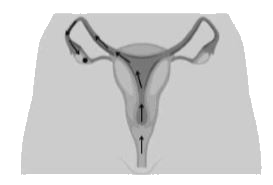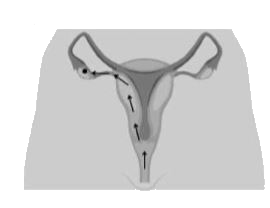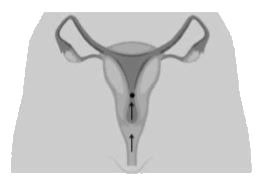Which of the following correctly represents the path taken by the sperm (indicated by the arrows) inside the female reproductive system till the point it may meet an egg cell (indicated by the point)?




The correct Answer is:B
To determine the correct path taken by sperm inside the female reproductive system until it may meet an egg cell, we need to understand the anatomy of the female reproductive system and the process of fertilization.
1. Understanding the Female Reproductive System: The female reproductive system consists of several parts: the vagina, cervix, uterus, fallopian tubes, and ovaries. The sperm must travel through these structures to reach the egg.
2. Pathway of Sperm: The journey of sperm begins in the vagina, where it is deposited during intercourse. From there, it moves through the cervix into the uterus.
3. Traveling to the Fallopian Tubes: After entering the uterus, the sperm continues its journey into the fallopian tubes. This is crucial because fertilization typically occurs in the fallopian tubes, where the sperm can meet the egg released from the ovary.
4. Meeting the Egg: The egg is released from the ovary during ovulation and travels into the fallopian tube. The sperm must reach the fallopian tube to fertilize the egg.
5. Identifying the Correct Option: Based on the above understanding, we can analyze the provided options. The correct path must show the sperm traveling from the vagina to the cervix, then into the uterus, and finally into the fallopian tube where it can meet the egg.
6. Conclusion: After evaluating the options, the second option correctly represents this pathway: sperm enters the uterus and then travels to the fallopian tube where fertilization occurs.
Topper's Solved these Questions
Similar Questions
Knowledge Check
- Question 1 - Select One or More
Which of the following reaction are correctly represented against their indicated colour?
ACuSO4(aq)+NH3(l)[excess]→ Deep blue solutionBNa3[Cu(CN)4](aq)+H2S→ Black ppt. of Cu2SCBiCI3(aq)+NaOH(aq)+Na2[Sn(OH4)](aq)→ Black ppt of BiDNa2[Fe(CN)5(NO)](aq)+H2SAlkaline−−−−→medium Purple/Violet colour solutions - Question 2 - Select One
Which one of the following does not correctly represent the correct order of the property indicated against it ?
ATI<V<Mn<Cr : increasing 2 nd ionization enthlpyBTi<V<cr<Mn : increasing number of oxidation statesCTi3+<V3+<Cr3+<Mn3+ : increasing magnetic momentDTi<V<Cr<Mn : increasing melting points - Question 3 - Select One
Which one of the following does not correctly represent the correct order of the property indicated against it
ATi<V<Cr<Mn, Increasing number of oxidation statesBTi3+<V3+<Cr3+<Mn3+: increasing magnetic momentCTi<V<Cr<Mn: increasing melting pointsDTi<V<Mn<Cr: increasing 2nd ionization enthalpy
Which one of the following does not correctly represent the correct order of the property indicated against it
View SolutionWhich of the following points belongs to the region indicated by the ineqation 2x+3y<−6 ?
View SolutionWhich of the following CORRECTLY represents the increasinf order of melting point of the compounds ?
View SolutionWhich of the following sets of quantum numvber is not correctly represented in case of the indicated series of hydrogen atom ?
View SolutionWhich of the following function has / have a reaovable discontinuity at the indicated point ?
View Solution
